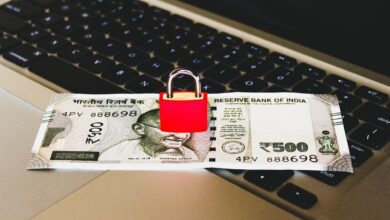18 Best Ways To Get Paid To Shop

Picture this: You’re standing in Target, cart full of groceries, and instead of watching your bank account shrink, you’re actually making money. Sounds too good to be true? Well, buckle up because I’m about to blow your mind 🙂
Look, we all need to shop anyway , groceries don’t buy themselves, and that Amazon addiction isn’t going anywhere anytime soon. But what if I told you there are legitimate ways to turn your shopping habit into a profitable side hustle?
After diving deep into this world for the past few years, I’ve discovered some pretty incredible opportunities that most people completely ignore.
Whether you want to earn a few extra bucks through cashback apps or turn personal shopping into a full-blown business, this guide covers every angle. Trust me, some of these methods will surprise you , I wish I’d known about them sooner!
Can You Really Get Paid To Shop?
Here’s the deal: Yes, absolutely. But let’s get one thing straight , we’re not talking about some magical fairy tale where money falls from the sky every time you swipe your card.
The reality is much more practical and frankly, more exciting. Companies desperately want your business, and they’re willing to pay for it through cashback programs, referral bonuses, and loyalty rewards.
Meanwhile, busy people everywhere need someone to handle their shopping, creating a massive market for personal shoppers.
I’ve personally tested dozens of these platforms, and while some are definitely better than others, the opportunities are real. The key is understanding which methods work best for your lifestyle and financial goals.
How Much Money Can You Make From Shopping?
Let’s talk numbers because that’s what you really want to know, right?
Cashback apps typically offer 1-6% back on purchases. If you spend $500 monthly on groceries, that’s $5-30 back. Not life-changing, but hey , free money is free money.
Personal shopping, however? That’s where things get interesting. Most personal shoppers earn $11-25 per hour, with experienced shoppers in high-demand areas pulling in even more. I know someone who makes $40+ per hour doing high-end personal shopping in Manhattan.
The math gets pretty attractive when you consider you can easily shop for 4-6 hours daily.
Mystery shopping pays anywhere from $10-50 per assignment, depending on the complexity. Some luxury brand mystery shops can pay $100+ for a single visit.
The bottom line? If you’re strategic about it, you could realistically earn $500-2,000+ monthly from various shopping opportunities. Not bad for doing something you already do anyway!
18 Best Ways To Get Paid To Shop
Alright, let’s dive into the good stuff. I’ve organized these methods by category so you can find what works best for your situation.
Cash Back Apps That Pay You To Shop
These apps are like having a friend who gives you money back every time you shop. The setup is simple, the rewards are real, and honestly, there’s no reason not to use them.
1. Ibotta
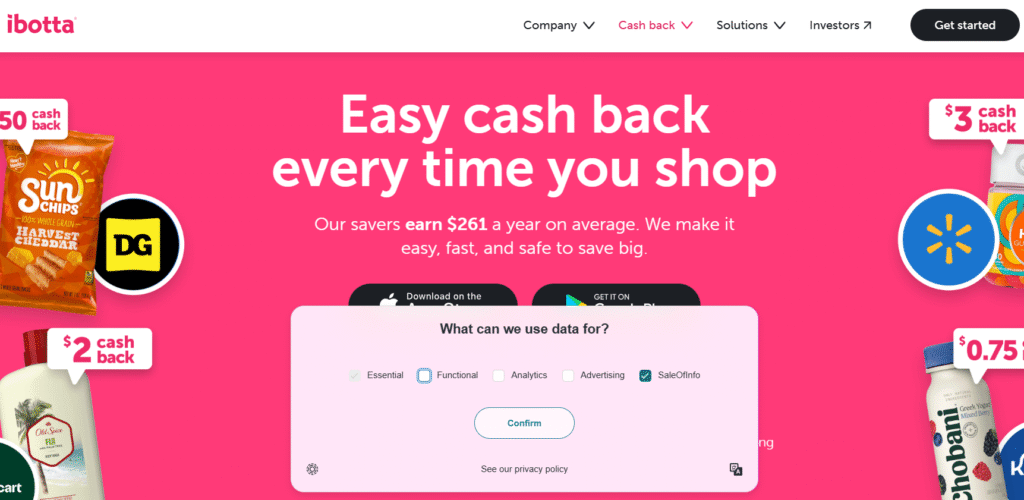
Ibotta is basically the OG of cashback apps, and for good reason. I’ve been using it for over three years, and it’s consistently delivered.
Here’s how it works: You browse available offers before shopping, buy the products, then scan your receipt. Boom , instant cashback. The app partners with major retailers like Walmart, Target, and Whole Foods, so you’re covered no matter where you shop.
The cool part? You can stack Ibotta with store sales and manufacturer coupons. I once scored a $15 cashback on a $20 grocery bill. Not joking.
Minimum payout: $20 (totally reasonable) My experience: Easy to use, reliable payments, great for grocery shopping
2. Rakuten
Remember when this was called Ebates? Yeah, Rakuten leveled up big time. This platform is perfect for online shopping addicts , and let’s be honest, that’s most of us these days.
The beauty of Rakuten lies in its browser extension. Install it, and it automatically alerts you when you’re shopping at a partner store. No need to remember to activate offers , it just works in the background like a money-making guardian angel.
I’ve earned over $400 through Rakuten just from my regular online purchases. The quarterly checks feel like surprise bonuses!
Minimum payout: $5 (super low barrier) Best for: Online shopping enthusiasts
3. Fetch Rewards
Fetch Rewards is the lazy person’s dream app , and I mean that in the best way possible. You literally just scan receipts from any store. No pre-activating offers, no hunting for specific products.
I keep this app on my phone and scan every single receipt. Gas station snacks? Points. Grocery run? Points. Random Target splurge? More points. It adds up faster than you’d expect.
Minimum payout: 3,000 points (roughly $3) Pro tip: Look for bonus point promotions , they happen frequently
Get Paid To Shop For Others: Grocery Shopping
Now we’re getting into the real money-making territory. Grocery delivery has exploded, and smart shoppers are cashing in.
1. Use Shipt
Shipt changed my perspective on gig work entirely. Unlike driving for rideshare apps where you’re basically running a taxi service, Shipt lets you combine shopping (which is actually fun) with decent pay.
The earnings: $15-25 per hour typically, but I’ve seen experienced shoppers hit $30+ during peak times. You get base pay plus tips, and trust me , good shoppers get tipped well.
Why I love it: You create your own schedule, shop at nice stores (mostly Target and grocery chains), and build relationships with regular customers who tip generously.
Requirements: Vehicle, smartphone, and basic people skills
2. Work With Instacart
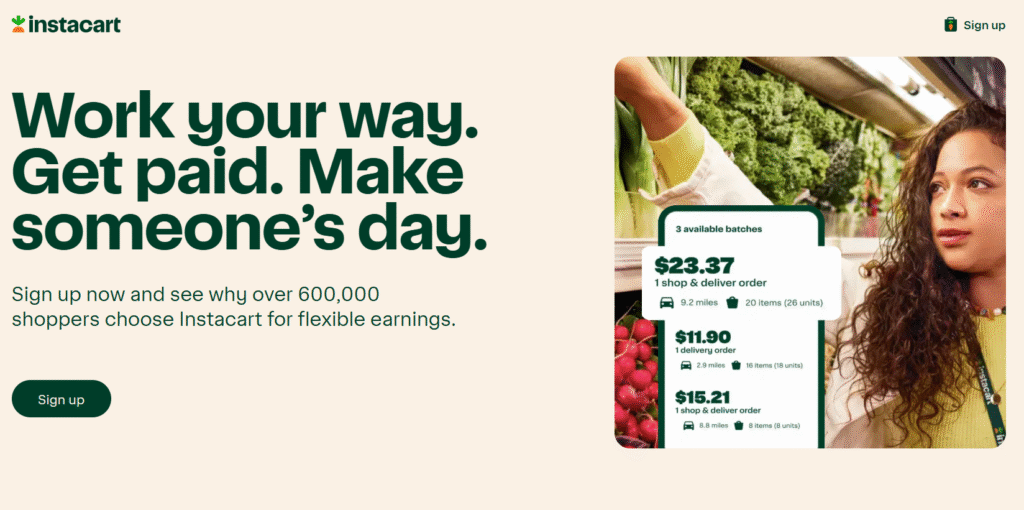
Instacart is probably the most well-known grocery delivery service, and for good reason. The platform offers flexibility that traditional jobs simply can’t match.
You have two options here:
- Full-service shopper: Shop and deliver (need a car)
- In-store shopper: Just shop, someone else delivers (no car needed)
I’ve talked to dozens of Instacart shoppers, and the consensus is clear: location matters. Urban areas with higher income levels typically mean better tips and more orders.
Average earnings: $12-20 per hour, but experienced shoppers in good markets can hit $25-30
3. Join Peapod
Peapod operates mainly in the Midwest and Eastern US, but if you’re in their service area, it’s worth considering.
The company focuses on employee positions rather than independent contractors, which means more stability but less flexibility. You’ll get benefits, consistent schedules, and steady pay , around $12.50 per hour to start.
Best for: People who prefer traditional employment over gig work
4. Shop With Safeway
Safeway has been expanding their delivery services aggressively, often partnering with Instacart for fulfillment. This creates opportunities for both direct employment and contractor work.
The grocery chain focuses on quality service, which means they’re willing to pay for good shoppers. Plus, Safeway tends to attract customers who appreciate quality and tip accordingly.
Ways To Get Paid As A Personal Shopper
Personal shopping isn’t just about groceries anymore. From clothing to electronics, people need help making purchasing decisions.
1. Walmart Personal Shopper
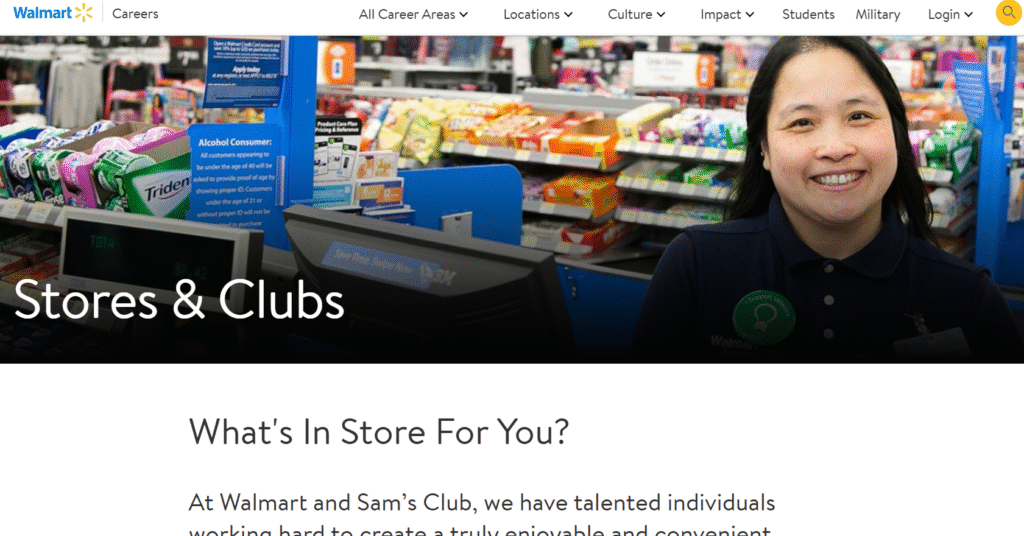
Walmart’s e-commerce growth has been insane, and they need people to keep up with demand. As a Walmart personal shopper, you work in-store, gathering online orders for delivery drivers.
The reality: This isn’t as flexible as gig work , you’ll work set shifts. But the pay is consistent, and you get employee benefits. Starting pay varies by location but typically ranges from $12-16 per hour.
Perfect if: You want stability and don’t mind a structured schedule
2. Amazon Personal Shopper
Amazon takes personal shopping seriously, especially with their Fresh and Whole Foods integration.
The Amazon advantage: Their “Anytime Pay” system lets you access 70% of your earned wages instantly. No waiting for payday when you need cash now.
The work involves assembling orders in Amazon Fresh warehouses or Whole Foods stores. It’s fast-paced but well-organized, and the technology they provide makes the job surprisingly efficient.
Starting pay: Usually $15+ per hour, depending on location
3. Set Up A Shopper Business
This is where things get really interesting. Why work for someone else when you can build your own personal shopping empire?
I know several people who’ve turned personal shopping into six-figure businesses. The secret? Specialization and premium service.
Getting started:
- Create a professional website and social media presence
- Focus on a specific niche (busy executives, elderly clients, new parents)
- Charge $25-50 per hour plus shopping costs
- Build relationships for recurring clients
Real talk: This takes more work upfront, but the earning potential is unlimited. One friend charges $75 per hour for luxury personal shopping in Beverly Hills. Location and target market matter enormously here.
Ways To Get Paid As A Mystery Shopper
Mystery shopping might sound sketchy, but legitimate companies use it for market research. I’ve done dozens of mystery shops, and it’s actually pretty fun.
1. BestMark
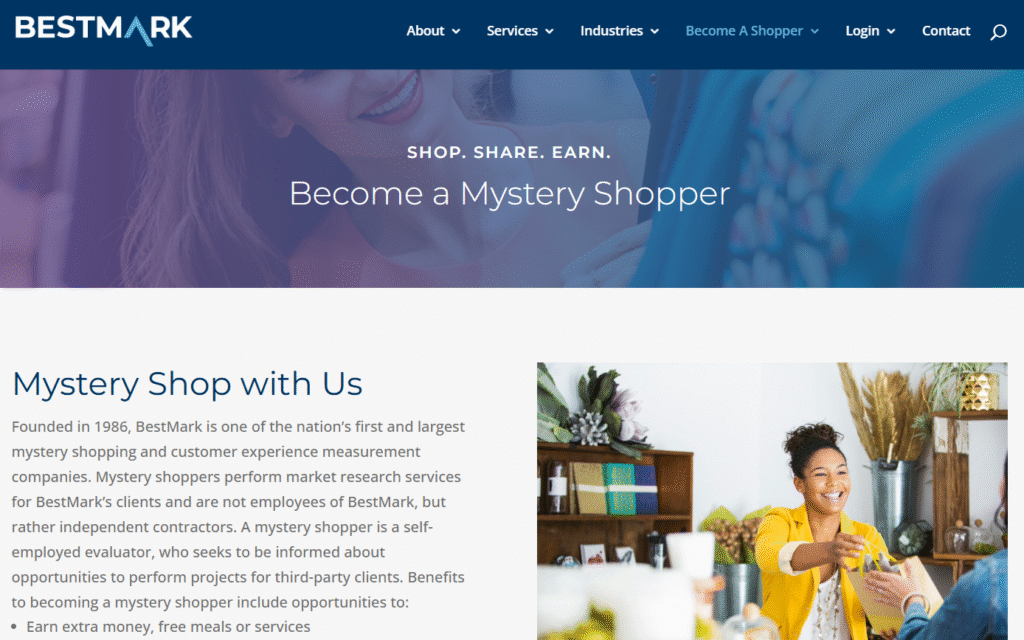
BestMark has been around since 1986 , practically ancient in internet years. With over 600,000 shoppers, they’re clearly doing something right.
What I love: The assignments are diverse. One week you’re evaluating a restaurant, the next you’re shopping at an electronics store. It keeps things interesting.
Pay range: $8-50 per assignment, depending on complexity Application process: Fill out their online form , no experience required
2. Market Force
Market Force works with 350+ brands across the US, Canada, and UK. Their Eyes:On app makes submitting reports incredibly easy , no more struggling with complicated paperwork.
The standout feature: Monthly payments via direct deposit or check. Reliable as clockwork.
Best assignments: Automotive and retail shops tend to pay the most in my experience
3. Intellishop
If you actually enjoy writing detailed reports (weird, I know), Intellishop might be your perfect match.
The ranking system: They rate shoppers based on performance. Higher ratings = better assignments = more money. It’s like leveling up in a video game, except you earn real cash.
I’ve seen top-rated shoppers get exclusive assignments paying $75+ for luxury store evaluations.
4. Secret Shopper
Secret Shopper is a founding member of the Mystery Shopping Providers Association , basically the gold standard for legitimacy in this industry.
What sets them apart: Comprehensive training before your first assignment. They actually care about quality, which means better relationships with client companies and more consistent work.
Payment: Monthly by check (old school but reliable)
Other Ways To Get Paid To Shop Online
These platforms offer unique approaches to earning money through shopping that don’t fit neatly into other categories.
1. Use Swagbucks
Swagbucks is like the Swiss Army knife of money-making apps. Sure, it’s famous for surveys and videos, but the shopping rewards are surprisingly solid.
The network: Over 7,000 partner stores means you’re covered for almost any online purchase. I’ve earned cashback on everything from office supplies to vacation bookings.
Payment options: Cash via PayPal or gift cards. The gift cards often offer better value , sometimes 12% more than cash equivalent.
2. Sign Up On Pogo
With a 4.9 rating on the App Store, Pogo clearly resonates with users. The setup is dead simple: connect your debit cards and earn points automatically.
Why it works: No hunting for offers or scanning receipts. Just shop normally and watch points accumulate. The survey opportunities provide nice bonus earnings too.
User experience: The app is genuinely well-designed. No clunky interfaces or confusing navigation.
3. Join Drop
Drop takes a personalized approach that I really appreciate. Instead of generic offers, you choose your favorite brands and earn higher rewards when shopping there.
Smart strategy: Pick brands you already shop at regularly. Why earn 1% everywhere when you can earn 3-5% at places you actually visit?
Gift card focus: While they don’t offer direct cash, the gift card selection is extensive. I usually grab Amazon cards since I shop there constantly anyway.
4. Receipt Hog
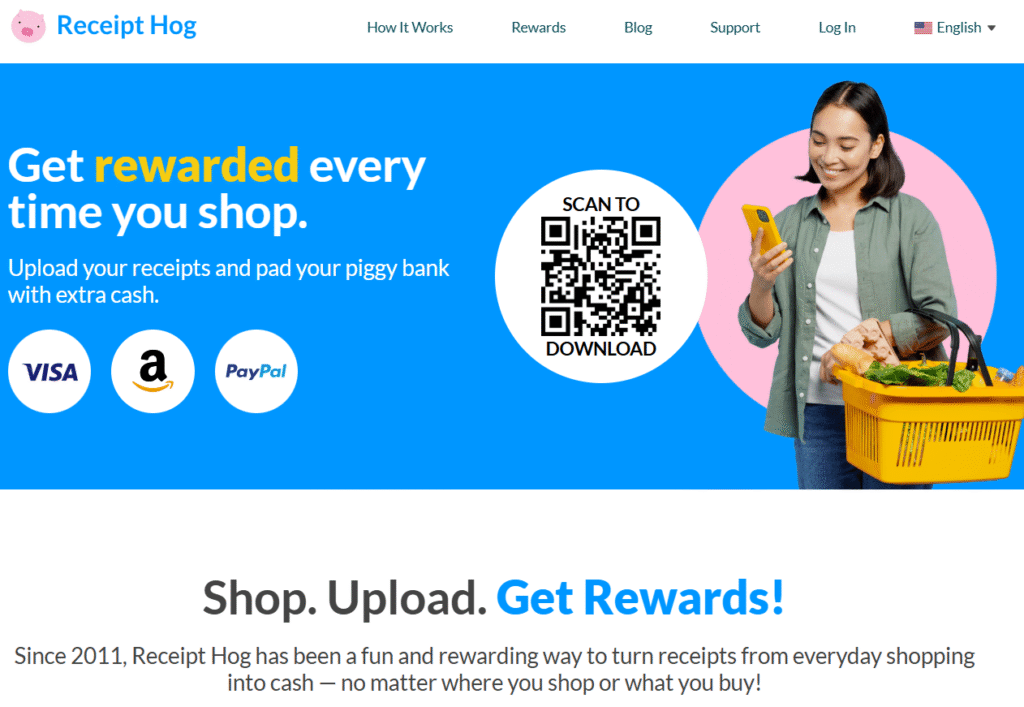
Receipt Hog wins the “most flexible” award hands down. Any store, any purchase , just scan the receipt and earn points.
This is perfect for people who shop at random places or prefer local businesses over big chains. I’ve earned points on everything from farmers market purchases to small boutique buys.
Bonus feature: They occasionally run sweepstakes where you can win significant cash prizes just for scanning receipts.
Success Tips For Getting Paid To Shop
Ready to maximize your shopping earnings? These strategies will help you squeeze every penny out of your efforts.
1. Use A Cashback Credit Card
This is where your finance degree kicks in; credit card rewards stacking is pure magic when done correctly.
Today’s cashback cards offer up to 6% in rotating categories. Chase Freedom and Discover It both rotate quarterly categories that often include grocery stores, gas stations, and online shopping.
My strategy: I have multiple cards optimized for different spending categories:
- 6% on groceries (up to spending limits)
- 5% on gas
- 3% on dining
- 2% on everything else
Pro tip: Always pay off the full balance monthly. Credit card interest will destroy any cashback gains faster than you can say “financial disaster.”
2. Shop For Others, Not Yourself
This might sound counterintuitive, but hear me out. If you’re trying to stick to a budget or live frugally, constantly shopping for cashback rewards will sabotage your financial goals.
The solution? Focus on personal shopping services where you earn actual wages instead of tiny cashback percentages.
I learned this lesson the hard way after realizing I was spending more money chasing rewards than I was earning back. Sometimes the best financial decision is earning $20/hour shopping for others rather than earning $2 back on your own $100 purchase.
3. Work With Multiple Platforms To Maximize Profit
Why limit yourself to one income stream when you can have several? The gig economy thrives on diversification.
My recommendation: Start with one platform to learn the ropes, then gradually add others. I know shoppers who work Amazon shifts in the morning, do Instacart batches in the afternoon, and complete mystery shopping assignments on weekends.
The scheduling sweet spot: Most grocery delivery services are busiest on weekends and evenings. Mystery shopping assignments are often more flexible and can fill your downtime.
4. Harness The Power Of Social Media
If you’re building your own personal shopping business, social media isn’t optional , it’s essential.
Platform strategies:
- Instagram: Showcase your shopping finds and behind-the-scenes content
- Facebook: Join local community groups and offer services
- Nextdoor: Perfect for neighborhood-based personal shopping
- TikTok: Share shopping tips and build a following
I’ve watched personal shoppers build massive followings by sharing their expertise. Some now earn more from sponsored content and affiliate marketing than from actual shopping services!
Content ideas: Shopping hauls, money-saving tips, product reviews, and day-in-the-life content all perform well.
5. Track Everything For Tax Purposes
Since you’re earning money, the IRS wants to know about it. As someone with a finance background, I can’t stress this enough: keep meticulous records.
What to track:
- All earnings from apps and platforms
- Business expenses (gas, phone bills, supplies)
- Mileage for delivery work
- Equipment purchases (insulated bags, phone mounts)
Tax implications: Most shopping income is considered self-employment income. You’ll likely need to pay quarterly estimated taxes if you earn over $400 annually.
Software recommendations: QuickBooks Self-Employed or even a simple spreadsheet works fine for tracking.
6. Optimize Your Route And Time Management
Efficiency equals earnings in the shopping world. The faster you complete assignments, the more money you make per hour.
Route optimization: Use apps like Waze or Google Maps to plan efficient routes. Group deliveries by location to minimize driving time.
Shopping efficiency: Learn store layouts, use shopping list apps, and develop relationships with store employees who can help you find items quickly.
Time management: Peak hours (weekends, evenings, holidays) offer higher pay and more tips. Plan your schedule accordingly.
Advanced Strategies For Serious Earners
Ready to take things up a notch? These strategies separate casual side-hustlers from serious money-makers.
1. Specialize In High-Value Clients
Luxury personal shopping pays significantly more than basic grocery delivery. Think busy executives, elderly clients with specific needs, or people with dietary restrictions requiring specialized products.
Building expertise: Learn about organic foods, luxury brands, dietary requirements, and accessibility needs. Specialized knowledge commands premium rates.
2. Build Long-Term Client Relationships
Recurring clients are the holy grail of personal shopping. Once someone trusts you, they’ll use your services regularly and refer friends.
Relationship building strategies:
- Remember client preferences
- Offer helpful suggestions
- Communicate proactively about delays or substitutions
- Go slightly above and beyond expectations
3. Leverage Technology
Smart shoppers use smart tools. Apps like Flipp help find the best deals, while grocery store apps often have exclusive digital coupons.
Tech stack recommendations:
- Mileage tracking apps (for taxes)
- Receipt scanning apps (multiple platforms for maximum rewards)
- Price comparison tools
- Inventory management apps (for business shoppers)
Common Mistakes To Avoid
Let me save you some headaches by sharing mistakes I’ve seen (and made) along the way.
1. Chasing Low-Value Rewards
Not all cashback opportunities are created equal. Time is money, and spending 30 minutes to earn 50 cents isn’t a good investment.
Focus on: High-percentage categories, bulk shopping opportunities, and platforms with reasonable minimum payouts.
2. Ignoring Customer Service
In personal shopping, your reputation is everything. One bad review can destroy weeks of positive momentum.
Customer service essentials:
- Communicate clearly about timing and availability
- Handle substitutions professionally
- Be punctual and reliable
- Resolve issues quickly and fairly
3. Underestimating Expenses
Vehicle expenses eat into profits faster than most people realize. Factor in gas, wear and tear, insurance implications, and maintenance costs.
Rule of thumb: If driving expenses exceed 30% of your earnings, reconsider your strategy or focus on walking-distance opportunities.
4. Not Diversifying Income Streams
Relying on a single platform is risky. Apps get discontinued, policies change, and market conditions fluctuate.
Diversification strategy: Use multiple cashback apps simultaneously, maintain accounts with several shopping platforms, and consider both employee and contractor opportunities.
Tax Considerations And Financial Planning
Since I have a finance background, let me share some crucial financial insights that most articles completely ignore.
Understanding Your Tax Obligations
1099-K forms will be issued for earnings over $600 from payment platforms like PayPal and Venmo. This means the IRS knows about your side income.
Self-employment tax: You’ll pay both employer and employee portions of Social Security and Medicare taxes (15.3% total) on net earnings over $400.
Quarterly payments: If you expect to owe more than $1,000 in taxes, you’re supposed to make quarterly estimated payments.
Business Expense Deductions
Vehicle expenses: You can deduct either actual expenses (gas, maintenance, insurance) or use the standard mileage rate (currently 65.5 cents per mile).
Equipment: Phone, insulated bags, cart covers, and other shopping tools are deductible business expenses.
Home office: If you use part of your home exclusively for managing your shopping business, you might qualify for home office deductions.
Building Financial Stability
Emergency fund first: Before scaling your shopping income, ensure you have 3-6 months of expenses saved. Gig work can be unpredictable.
Retirement planning: Self-employment income allows you to contribute to SEP-IRAs or Solo 401(k)s, potentially saving more for retirement than traditional employees.
Income smoothing: Set aside 25-30% of earnings for taxes and business expenses. This prevents cash flow problems during tax season.
The Future Of Paid Shopping
The shopping economy is evolving rapidly, and smart people are positioning themselves for future opportunities.
Emerging Trends
AI-powered shopping is creating new roles for human shoppers who can provide personalized recommendations that algorithms can’t match.
Sustainable shopping services are growing as people seek eco-friendly alternatives without the research hassle.
Specialty dietary shopping (keto, vegan, gluten-free) represents a growing niche with premium pricing potential.
Technology Integration
Augmented reality shopping tools are being tested by major retailers. Early adopters who learn these technologies will have competitive advantages.
Blockchain-based rewards programs might revolutionize how cashback and loyalty points work.
Market Opportunities
Rural delivery remains underserved in many areas. Shoppers willing to serve less populated areas often face less competition and higher per-delivery rates.
Senior services represent a massive growth opportunity as Baby Boomers increasingly embrace technology-enabled shopping.
Final Words On The Best Ways To Get Paid To Shop
Give me your attention: The days of easy money are largely over, but smart money is still very much available. Whether you’re looking to earn an extra $100 monthly through cashback apps or build a $2,000+ monthly income through personal shopping services, the opportunities exist.
My honest advice? Start with one or two methods that match your current lifestyle. Master those, then gradually expand. Don’t try to do everything at once, you’ll burn out and probably do everything poorly. The question isn’t whether these opportunities will exist, it’s whether you’ll take advantage of them.



